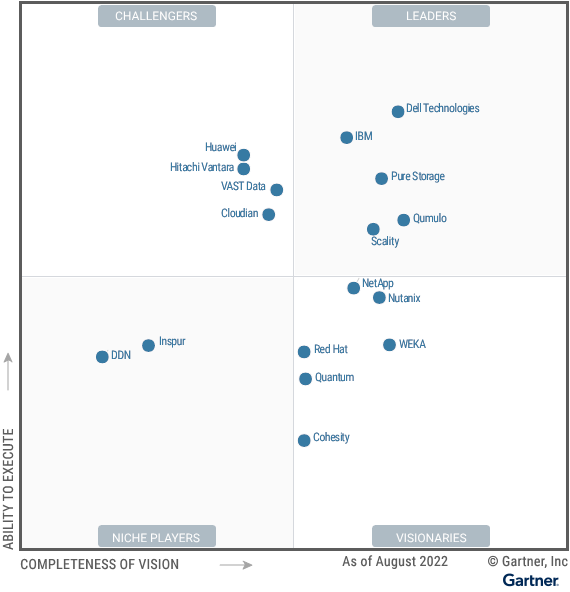Companies that were looking to store tens of petabytes of unstructured data previously had two main flavors of storage they could turn to: object storage and distributed file systems. Those two classes of storage have now merged, according to Gartner, which says the leading providers satisfy both storage modalities with a single offering.
When we visited this topic two years ago, the analysts at Gartner said object storage and distributed file systems were in the process of becoming one. With last week’s release of its 2022 Magic Quadrant for Distributed File Systems and Object Storage, they have completed the merge, the analyst group says.
 “The markets for distributed file systems and object storage have merged,” Gartner analysts Julia Palmer, Jerry Rozeman, Chandra Mukhyala, and Jeff Vogel write in their October 19 report. “The distinctions between the two segments are blurring, and buyers are already treating it as one market and requiring both file and object access for unstructured datasets. To address it, the most innovative vendors now offer file and object services on a common data store, typically a key-value store.”
“The markets for distributed file systems and object storage have merged,” Gartner analysts Julia Palmer, Jerry Rozeman, Chandra Mukhyala, and Jeff Vogel write in their October 19 report. “The distinctions between the two segments are blurring, and buyers are already treating it as one market and requiring both file and object access for unstructured datasets. To address it, the most innovative vendors now offer file and object services on a common data store, typically a key-value store.”
Customers currently are ramping up their investments in distributed file systems and object storage as they chase the growth of unstructured data, which is increasingly 30% annually, Gartner says. Over the next four years, large enterprises will grow their object stores and distributed file system capacity by 300%, Gartner says.
Forty percent of this object and distributed file system storage capacity will be deployed on the edge over the next three years, Gartner says, a significant jump from today, which has just 15% of such storage capacity on the edge. Additionally, hybrid cloud architectures will be used in 60% of deployments, the analyst group says.
Vendors in the leader’s section of Gartner’s Magic Quadrant – including Pure Storage, Qumulo, and Scality – are bullish on their prospects to grow their share of this storage market.
“Qumulo believes its position in the Leader quadrant is evidence of our suitability for the most mission-critical and large-scale workloads, whether they are run on-premises or in the cloud,” the company says in a press release.
“We believe our positioning in the Magic Quadrant for Distributed File Systems & Object Storage validates our commitment to helping our customers meet the data demands of today and tomorrow,” Jérôme Lecat, CEO of Scality, says in a press release.
“We believe Pure’s position as a Leader is further validation of our continued efforts to deliver a flexible, scalable and powerful platform that can tackle the critical unstructured data challenges modern enterprises experience,” Matt Burr, vice president and general manager of FlashBlade for Pure Storage, stated in a press release.
Not a Monolith
Distributed file systems typically use a protocol like Network File System (NFS) to access individual files in a network attached storage (NAS) configuration. Some file systems also utilize Server Message Block (SMB) or Common Internet File System (CIFS) protocols. Object stores, on the other hand, almost universally use Amazon Web Services’ Simple Storage Service (S3), a REST-based protocol, to access objects.
While Gartner sees object stores and distributed file systems converging, that doesn’t mean there’s uniformity across the product range. In fact, there are some significant differences among the various vendors’ products, including what file interfaces and protocols they support. Deployment mode is another source of differentiation, as some of these offerings are software-defined storage (SDS) products while others are deployed on pre-built appliances.
Here are some of the plusses and minuses for each of the 17 object-and-file-storage vendors cited by Gartner in its report.
Leaders
Gartner applauded Dell Technologies’ recent improvements to its PowerScale distributed file system, including the ability to move file data into S3 buckets, support NFS over RDMA, and ransomware upgrades. However, it cited drawbacks, such as a lack of support for parallel NFS (nNFS) or other mechanisms to address workloads that require parallel access from a compute farm. It also mentioned Dell’s lacks a file-based offering for AWS and Microsoft Azure (it only runs on Google Cloud) for its PowerScale and Isilon offerings.
IBM made the Leader’s quadrant with a mix of various scale-out storage offerings, including Spectrum Scale, a high-performance parallel file system that also offers an S3 interface that can run via on-prem appliances or in clouds. It also offers IBM Cloud Object Storage (COS), which is based on its 2015 acquisition of object storage vendor Cleversafe. IBM was praised for the containerization of its storage offering. However, Big Blue was dinged for relying on partners to manage customers cloud-based file system deployments, and not offering its own branded storage-as-a-service offering.
Pure offers object and file protocols with FlashBlade, its storage appliance that scales linearly to handle “massive file and object throughput and parallelism,” Gartner says. The cost of the FlashBlade arrays was the biggest downer, per Gartner, as was its hybrid cloud strategy.
Qumulo offers a cloud-native object and file store that supports NFSv4.1 and S3 protocols and is available on all three major public clouds. The biggest dings were the “size and breadth of hybrid offerings;” lack of full integration into HPE InfoSight; and lack of support on Azure EMEA data centers.
Scality checks the biggest boxes with RING’s support for object and file storage services, as well as on-prem and cloud deployments. The biggest drawbacks were the relative smallness of RING’s installed base; support for low-latency file access (needed for analytics); and a certain level of expertise to manage.
Challengers
Cloudian HyperStore ticks all the right boxes for scale-out object storage for high-throughput workloads. It runs on-prem and in all the public clouds. But HyperStore was dinged for using an external “add-on” file gateway for file system workloads, which limits scale-out capabilities, according to Gartner.
Hitachi Vantara’s object storage system, Hitachi Content Platform (HCP), is flexible in that it can be deployed as appliance, as a software-only offering, in the cloud, or on-premises. However, the vendor, which is listed in the Challenger’s quadrant, leans on partner Weka for its file system, which requires a “coordinated partnership approach to effectively support performance-intensive, file-heavy workload,” it says.
Huawei’s OceanStor Pacific supports both file and object protocols, and it’s well-suited for large-scale unstructured data workloads, Gartner says. However, it’s largely unproven outside of the Asia/Pacific region, the analyst group says (and the national security use restrictions probably don’t help in the US).
Visionaries
Cohesity SmartFiles offers file object interfaces for on-prem and cloud storage. It added NFSv4 in the past year, as well as S3 object locking. The lack of deployments, owing to the products relative newness, as well as the lack of some advanced capabilites, were the biggest drawbacks, per Gartner.
NetApp offers multiple deployment options for its StorageGRID, including on-prem appliances and SaaS in the cloud. But one thing it lack is a native file system interface, leaving customers to use an external solution. It was listed in the Visionary quadrant.
Nutanix, also a Visionary, offers both NFS and S3 interfaces via Nutanix Files and Nutanix Objects, which are components of the Nutanix Cloud Platform. The biggest fault cited by Gartner (besides being a “premium” offering, which sounds more like a strength), was the lack of data deuplication and the fact that the only cloud supported by Nutanix is AWS.
Quantum made the cut as a Visionary for its ActiveScale offering, which offers S3 and NFS/SMB interfaces. Gartner applauded Quantum for its acquisition of Pivot3, which bolsters the vendor’s standing in the video surveillance market. But it says the product lacks data de-duplication, support for NFSv4, distributed SMB, and dual protocol access.
Red Hat (owned by IBM) made the Visionaries quadrant for Ceph Storage, which supports block, object, and file workloads. While Ceph Storage is appealing for open source backers, several cautions are in play, according to Gartner, including a low number of deployments for large production environments for Red Hat Ceph File System (CephFS), and complexity and manageability issues.
VAST Data develops all-flash appliances that offer distributed file and object storage interfaces. Scalability, throughput, customer support, and brand awareness for high-end use cases aren’t issues for VAST. But the lack of features like geodistributed erasure coding, ransomware detection, synchronous replication, and public cloud integration are for Gartner.
WEKA has turned some heads in the HPC and AI industries with WekaFS, which is suitable for high-performance file use cases on prem or in the cloud. While the young company supports object storage interfaces, it’s generally not considered for object or general-purpose file system use cases, according to Gartner.
Niche Players
DDN’s EXAScaler is a distributed file system that runs on-prem and in the cloud, and supports large-scale, high-throughput use cases, as DDN’s heritage in HPC shows. However, EXAScaler’s S3 interface is intended for archival use only, Gartner says.
Chinese server vendor Inspur, which offers IBM Power-based systems, ticks both object and file boxes with its AS13000G6 unified storage offering. Gartner was impressed with performance optimization algorithms. But usage outside of Asia/Pacific is limited, and the reliance on a proprietary SSD for some capabilities doesn’t help its marketability in the U.S.
A version of this article first appeared on sister website Datanami.





























































